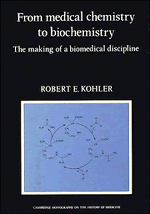Book contents
- Frontmatter
- Contents
- 1 Introduction: On discipline history
- 2 Physiological chemistry in Germany, 1840–1900
- 3 Physiology and British biochemists, 1890–1920
- 4 General biochemistry: the Cambridge school
- 5 European ideals and American realities, 1870–1900
- 6 The reform of medical education in America
- 7 From medical chemistry to biochemistry: the emergence of a discipline
- 8 Unity in diversity: the American Society of Biological Chemists
- 9 The clinical connection: biochemistry as applied science
- 10 Chemical ideals and biochemical practice
- 11 Biological programs
- 12 Epilogue: Toward a molecular biology?
- Location of archival sources and abbreviations
- Notes
- Index
5 - European ideals and American realities, 1870–1900
Published online by Cambridge University Press: 07 October 2011
- Frontmatter
- Contents
- 1 Introduction: On discipline history
- 2 Physiological chemistry in Germany, 1840–1900
- 3 Physiology and British biochemists, 1890–1920
- 4 General biochemistry: the Cambridge school
- 5 European ideals and American realities, 1870–1900
- 6 The reform of medical education in America
- 7 From medical chemistry to biochemistry: the emergence of a discipline
- 8 Unity in diversity: the American Society of Biological Chemists
- 9 The clinical connection: biochemistry as applied science
- 10 Chemical ideals and biochemical practice
- 11 Biological programs
- 12 Epilogue: Toward a molecular biology?
- Location of archival sources and abbreviations
- Notes
- Index
Summary
Because Germany was so advanced in developing scientific disciplines, German influence was inevitably a major force in the development of the biomedical sciences in Austria, Russia, Japan, Scandinavia, and the United States. Some German laboratories had more foreign than German students. Walter Jones's description of the polyglot character of Kossel's institute at Marburg is typical:
On the day of my arrival I met a young Russian named [Phoebus] Levene who has worked for several years in New York.…Levene introduced me to two of his Russian friends, that is I believe he introduced me to them for it was done in the Russian language and I cannot be certain. These three Russians, a Frenchman, an Englishman, an Irish professor from Belfast named Thompson, the two assistants, another German and myself are the present workers in the Physiological Research Laboratory. It often happens that several of us go out together to dinner and you would be amused to hear the four languages.
Some universities organized special courses in English, and foreign students were regarded as an important vehicle of German cultural imperialism.
Apart from Russia, the United States was probably the most avid consumer of German Wissenschaft. It has been estimated that about 15,000 American doctors studied in German (or Austrian) universities prior to 1914, or about one-third of the upper elite of American physicians. The importance of German contacts in agricultural chemistry and in the establishment of American agricultural experiment stations has also been documented.
- Type
- Chapter
- Information
- From Medical Chemistry to BiochemistryThe Making of a Biomedical Discipline, pp. 93 - 120Publisher: Cambridge University PressPrint publication year: 1982

